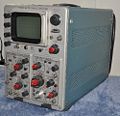647: Difference between revisions
No edit summary |
No edit summary |
||
| Line 26: | Line 26: | ||
* [http://w140.com/RM647_schematics.pdf Tektronix RM647 Schematics (large format, PDF)] | * [http://w140.com/RM647_schematics.pdf Tektronix RM647 Schematics (large format, PDF)] | ||
* [http://bama.edebris.com/download/tek/647a/tek%20647a.djvu Tektronix 647A Manual (DjVu)] | * [http://bama.edebris.com/download/tek/647a/tek%20647a.djvu Tektronix 647A Manual (DjVu)] | ||
* [http://w140.com/tek_647_tentative.pdf Tektronix 647 Tentative Specifications (PDF)] | |||
Revision as of 20:32, 24 January 2013
The 647 is a 50 MHz oscilloscope with plug-ins for both vertical and horizontal deflection. The intent was to offer a higher performance scope in a small form factor, roughly the size and weight of the 560 series. The system is nearly all solid state, the exception of the three 5642 HV rectifier tubes used in the CRT circuit. The 647 was promoted as “ruggedized” with an extended operating temperature range, and higher shock and vibration ratings than previous lab grade instruments. The 647 was introduced in late 1963, along with a minimal set of plug-ins. It was replaced by the higher bandwidth 647A in 1967.
The 647 uses 10 series vertical and 11 series time base plug-ins. At introduction, the 10A2 a dual channel 50 MHz vertical, 11A1 single time base, and 11A2 dual time base were offered. The plug-ins were unique to the 647 and 647A. Unlike the threaded knob used for retaining the 530/540 series plug-ins, the 647 used a lever actuated cam mechanism. The single lever both engaged and disengaged the plug-in with a quick, smooth motion. Many users considered it to be the best plug-in retaining system Tek had ever offered.
Unlike the 560 series where the plug-ins directly drive the CRT deflection plates, the 647 has amplifiers for both the vertical and horizontal signals in the mainframe. In addition to supporting the higher bandwidth, the amplifiers provide a normalized gain at the plug-in interface, eliminating the need to adjust the gain or sweep cal every time a plug-in was swapped.
The vertical amplifier also contained a delay line. The interface between the vertical plug-in and the mainframe is a 93-ohm controlled-impedance connection. This is in contrast to the 500-series scopes, which appear to the plug-in as a high impedance.
The horizontal and vertical plugs are not electrically interchangeable. Only a 10 series plug-in will work in the vertical compartment, and only a 11 series time base will work in the horizontal compartment. X-Y mode requires the use of the external horizontal input in an 11 series time base.
- Tektronix 647 Manual (PDF)
- Tektronix RM647 Schematics (large format, PDF)
- Tektronix 647A Manual (DjVu)
- Tektronix 647 Tentative Specifications (PDF)
-
647A front view
-
647A left view
-
647A right view
-
647A rear view
-
R647A front view
-
RM647 front view
-
R647 inside view
-
Special R647A for US Air Force
-
Rear panel of the Air Force R647A







